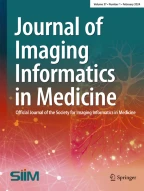Abstract
The use of color LCDs in medical imaging is growing as more clinical specialties use digital images as a resource in diagnosis and treatment decisions. Telemedicine applications such as telepathology, teledermatology, and teleophthalmology rely heavily on color images. However, standard methods for calibrating, characterizing, and profiling color displays do not exist, resulting in inconsistent presentation. To address this, we developed a calibration, characterization, and profiling protocol for color-critical medical imaging applications. Physical characterization of displays calibrated with and without the protocol revealed high color reproduction accuracy with the protocol. The present study assessed the impact of this protocol on observer performance. A set of 250 breast biopsy virtual slide regions of interest (half malignant, half benign) were shown to six pathologists, once using the calibration protocol and once using the same display in its “native” off-the-shelf uncalibrated state. Diagnostic accuracy and time to render a decision were measured. In terms of ROC performance, Az (area under the curve) calibrated = 0.8570 and Az uncalibrated = 0.8488. No statistically significant difference (p = 0.4112) was observed. In terms of interpretation speed, mean calibrated = 4.895 s; mean uncalibrated = 6.304 s which is statistically significant (p = 0.0460). Early results suggest a slight advantage diagnostically for a properly calibrated and color-managed display and a significant potential advantage in terms of improved workflow. Future work should be conducted using different types of color images that may be more dependent on accurate color rendering and a wider range of LCDs with varying characteristics.
Similar content being viewed by others
References
Geijer H, Geijer M, Forsberg L, et al: Comparison of color LCD and medical-grade monochrome LCD displays in diagnostic radiology. J Digit Imaging 20:114–121, 2007
Lowe JM, Brennan PC, Evanoff MG, McEntee MF: Variations in performance of LCDs are still evident after DICOM gray-scale standard display calibration. Am J Roentgenol 195:181–187, 2010
Butt A, Mahoney M, Savage NW: The impact of computer display performance on the quality of digital radiographs: a review. Aust Dent J 57:16–23, 2012
Wang J, Xu J, Baladandayuthapani V: Contrast threshold sensitivity of digital imaging display systems: contrast threshold dependency on object type and implications for monitor quality assurance and quality control in PACS. Med Phys 36:3682–3692, 2009
Fetterly KA, Blume HR, Flynn MJ, Samei E: Introduction to grayscale calibration and related aspects of medical imaging grade liquid crystal displays. J Digit Imaging 21:193–207, 2008
Krupinski EA: Medical grade vs off-the-shelf color displays: influence on observer performance and visual search. J Digit Imaging 22:363–368, 2009
Krupinski EA, Roehrig H: The influence of a perceptually linearized display on observer performance and visual search. Acad Radiol 7:8–13, 2000
Krupinski EA, Burdick A, Pak H, et al: American Telemedicine Association's practice guidelines for teledermatology. Telemed J E Health 14:289–302, 2008
Cavalcanti PG, Scharcanski J, Lopes CBO: Shading attenuation in human skin color. In: Bebis G, Boyle R, Parvin B, et al Eds. Advances in visual computing 6th International Symposium. Springer, Berlin, 2010, pp 190–198
Li HK, Esquivel A, Techavipoo U, et al: Teleophthalmology computer display calibration. Invest Ophthalmol Vis Sci 46:4580, 2005. E-abstract
Li HK, Esquivel A, Hubbard L, et al: Mosaics versus early treatment diabetic retinopathy seven standard fields for evaluation of diabetic retinopathy. Retina 31:1553–1563, 2011
Ricur G, Zaldivar R, Batiz MG: Cataract and refractive surgery post-operative care: teleophthalmology's challenge in Argentina. In: Yogesan K, Kumar S, Goldschmidt L Eds. Teleophthalmology. Springer, Berlin, 2006, pp 213–226
Van Poucke S, Haeghen YV, Vissers K, et al: Automatic colorimetric calibration of human wounds. BMC Med Imag 10:7, 2010
Weinstein RS, Graham AR, Richter LC, et al: Overview of telepathology, virtual microscopy, and whole slide imaging: prospects for the future. Hum Pathol 40:1057–1069, 2009
Krupinski EA: Optimizing the pathology workstation “cockpit”: challenges and solutions. J Pathol Inform 1:19, 2010
Yagi Y, Gilbertson JR: Digital imaging in pathology: the case for standardization. J Telemed Telecare 11:109–116, 2005
Yagi Y, Gilbertson JR: Digital pathology from the past to the future. J eHealth Tech App 8:73–80, 2010
Yagi Y: Color standardization and optimization in whole slide imaging. Diagn Pathol 6:1–15, 2011
Saha A, Kelley EF, Badano A: Accurate color measurement methods for medical displays. Med Phys 37:74–81, 2010
Cheng WC, Caceres H, Badano A: Evaluating color calibration kits with virtual display. Proc SPIE Med Imag 8292:82920A, 2012
Silverstein LD, Hashmi SF, Lang K, Krupinski EA: Paradigm for achieving color reproduction accuracy in LCDs for medical imaging. J Soc Info Disp In Press, 2012
International Color Consortium: Specification ICC.1:2004–10, Image technology colour management-Architecture, profile format, and data structure. 2006
Weinstein RS, Descour MR, Liang C, et al: An array microscope for ultrarapid virtual slide processing and telepathology. Design, fabrication, and validation study. Hum Pathol 35:1303–1314, 2004
Dorfman DD, Berbaum KS, Metz CE: Receiver operating characteristic rating analysis: Generalization to the population of readers and patients with the jackknife method. Invest Radiol 27:723–731, 1992
Acknowledgments
This work was supported in part by NIH/ARRA grant 1R01EB007311-01A2.
Author information
Authors and Affiliations
Corresponding author
Rights and permissions
About this article
Cite this article
Krupinski, E.A., Silverstein, L.D., Hashmi, S.F. et al. Observer Performance Using Virtual Pathology Slides: Impact of LCD Color Reproduction Accuracy. J Digit Imaging 25, 738–743 (2012). https://doi.org/10.1007/s10278-012-9479-1
Published:
Issue Date:
DOI: https://doi.org/10.1007/s10278-012-9479-1
